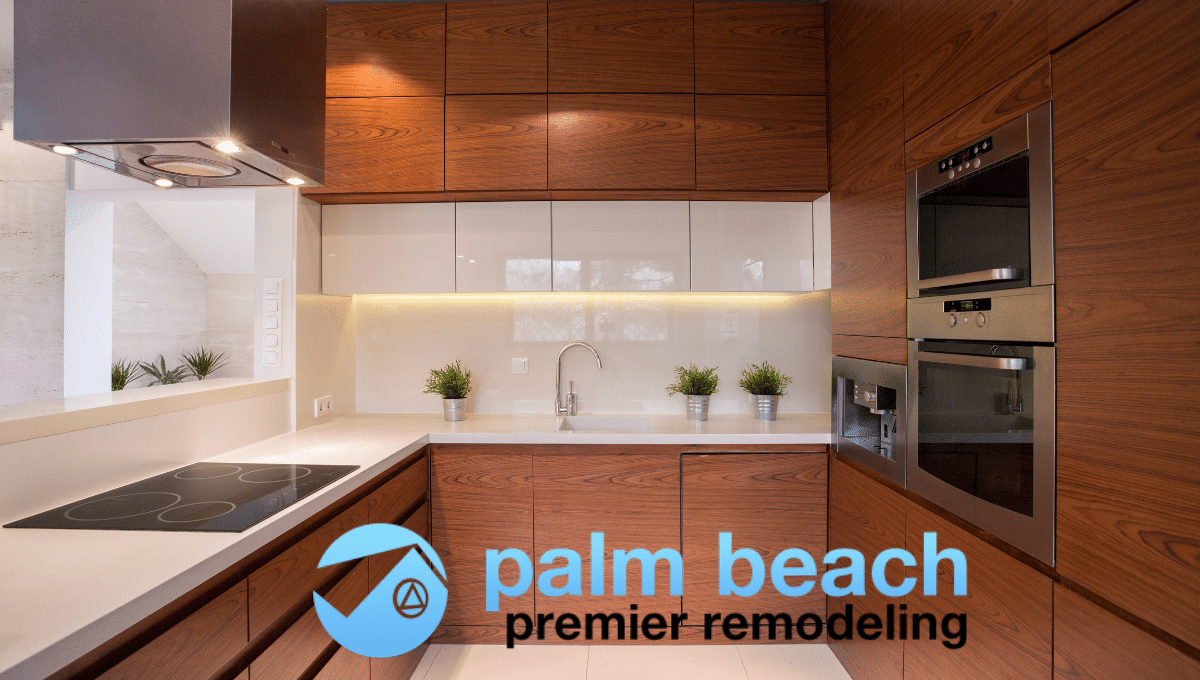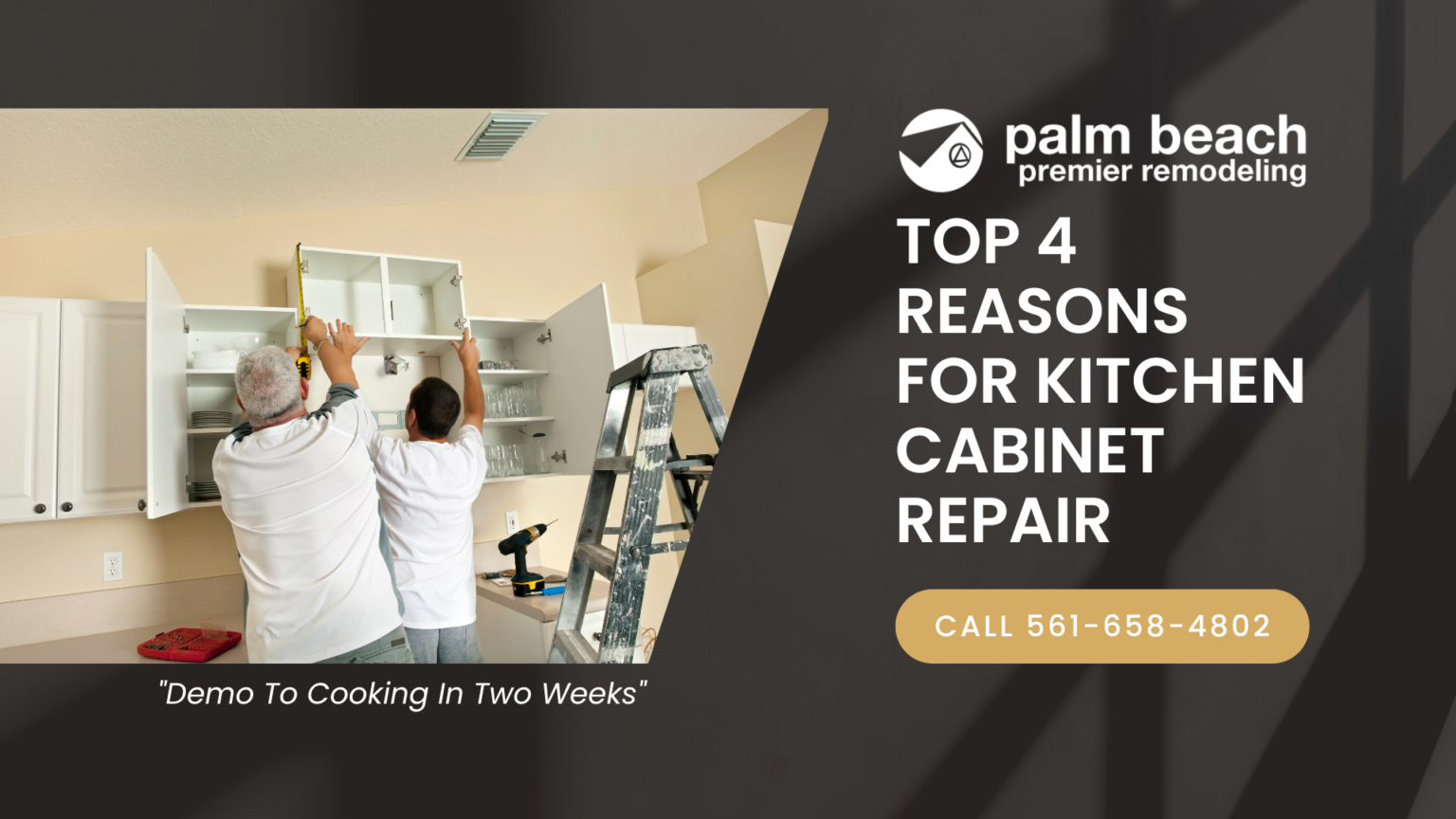Kitchen cabinets can last for generations with little care and maintenance from time to time. But even the highest-quality cabinets may need minor upkeep on occasions, such as repairing scratches and loose hinges or patching and re-drilling screw holes. In many cases, cabinet repairs are simple enough to handle yourself, but for sagging shelves or problematic hinges, it may be time to call a cabinet repair professional.
Table of Contents
Warping And Water Damage
Since most kitchen cabinets are crafted from wood, water damage is a likely occurrence. Wood can easily be damaged by water, and in your kitchen, there is always a lot of water, especially if you leak somewhere.
In some minor instances, water-damaged cabinets can be fixed. Here are signs of more serious water damage if the:
- Wood has started to warp.
- Cabinets are bubbling up on the inside or outside.
- Outsides are de-laminating.
- Wood has started to blacken, or otherwise change colors.
- Cabinets show signs of mold.
- Cabinets do not open or close properly.
The first step is always to find and then stop the source of the water from getting into the wood. Next, you want to sufficiently dry out the cabinet. Once dry, the appropriate repairs can be made, if possible. This will include replacing certain parts and bleaching out stains, a process that can take some time and money. You want to be sure that it is possible to repair your cabinets before embarking on the task.
Misaligned Cabinet Doors And Drawers
Cabinets with modern European hinges that attach inside the cabinet usually have screws that can be tightened or loosened to change the door alignment. If your cabinet doors no longer line up as they used to and all the hinge screws seem tight, the hinges may need adjustment.
The adjustment process varies from one brand and style to the next, as do the number of screws per hinge, but you can figure out the basic adjustments by tightening and loosening screws and noting the effect on the door’s alignment. Look for indentations near screw heads as an indication of what that screw adjusts. For instance, if the indentation is to the left or right of the screw, adjusting that screw moves the door left and right.
A groove or indentation above or below the screw head means the screw controls the height of the door. In some cases, you’ll have to loosen two screws and slide the door farther up or down and then tighten them once the door is in an ideal alignment. A screw-in area without an indentation usually controls how far in or out the door sits when the door is closed.

Peeling, Scratches, And Nicks To The Cabinets
Solid wood cabinets are a luxury. Most modern kitchen cabinets are made from laminated plywood or particleboard, and the lamination has a nasty habit of peeling away when it gets wet or sometimes even when it’s dry. You can usually fix lifting laminate yourself, but if moisture was the cause of the peeling, you have to make sure everything dries out before you attempt the repair, and you have to do something about the source of the moisture.
If the humidity in your kitchen is unusually high, consider opening windows or using fans to keep air circulating and to prevent condensation from settling. Once things have dried out, use a flat bar to gently pry back the lifting laminate far enough to get a paintbrush under it, and then use the brush to spread contact cement on the back of the laminate and the surface of the plywood or laminate.
Damage Screw Holes And Bad Hinges
If the hinge screws spin in place when you try to tighten them, your cabinet repair project is simply a matter of filling and possibly re-drilling the screw holes. Particleboard and fiberboard cabinets are particularly prone to this problem because any force that yanks screws from their holes can pull some of the wood material out with it.
How We Can Help You
Before spending the money, time, and effort it takes to repair cabinets you want to be sure that you are making the right decision. Sometimes cabinets need to be replaced simply because they have gotten old and worn out. In other instances, cabinets prematurely wear out long before they should. In this instance, you will want to identify the reasons your cabinets have worn out beyond repair to make sure that the same problem does not happen again.
Even if you purchase all new cabinets you will not be able to stop the problem from happening again if you do not first solve the issue that caused your original cabinets to wear out. Check over your cabinets for any signs of warping or swelling, especially cabinets regularly exposed to humidity and water. If your cabinets are warping due to humidity, a humidifier can help slow down the damage.
We offer a free consultation for the best solutions to your damaged cabinets.
Frequently Asked Questions
Can you repair a kitchen cabinet?
Yes, kitchen cabinets can be repaired in most cases. The extent of the repair depends on the type and severity of the damage. Minor scratches, dents, or discoloration can often be fixed with a simple touch-up or refinishing job. However, if there is structural damage or extensive water damage, it may require more extensive repairs, such as replacing the affected parts.
If you have basic DIY skills, you may be able to handle minor repairs yourself. Hiring a professional cabinet repair or restoration service for larger repairs is best. They will have the necessary tools and expertise to fix the problem correctly and ensure that the cabinet looks and functions as well as new.
It’s also worth noting that regular maintenance and care can prevent many issues from arising in the first place. Wiping down the cabinets regularly and avoiding harsh chemicals and abrasive materials can help keep them looking their best and extend their lifespan.
When should kitchen cabinets be replaced?
Kitchen cabinets should be replaced when they are beyond repair or when they no longer meet your needs or style preferences. Here are some common signs that it may be time to replace your kitchen cabinets:
- Structural damage: If your cabinets are sagging, the doors won’t close properly, or the drawers are falling apart, it may be time for a replacement.
- Water damage: If your cabinets have been exposed to water and are starting to warp or show signs of mold or mildew, it may be best to replace them.
- Outdated style: If your cabinets are old-fashioned or no longer fit the style of your home, it may be time to replace them with newer models.
- Lack of functionality: If your cabinets no longer provide adequate storage or functionality for your needs, it may be time to consider replacing them with cabinets that better meet your requirements.
- Home renovation: If you are renovating your kitchen or updating your home, replacing your cabinets can be a great way to refresh the space and add value to your property.
Ultimately, the decision to replace your kitchen cabinets will depend on your individual circumstances and preferences. If you’re unsure whether it’s time to replace your cabinets, consulting with a professional contractor or designer can help you make an informed decision.
What is the useful life of cabinets?
The useful life of kitchen cabinets can vary depending on several factors, including the quality of materials, construction, and the level of maintenance and use. Generally speaking, high-quality cabinets made from hardwood or engineered wood can last anywhere from 20 to 50 years or more with proper care and maintenance.
However, cabinets made from less durable materials, such as particleboard or medium-density fiberboard (MDF), may have a shorter lifespan of around 10 to 15 years. Poorly constructed cabinets may also have a shorter useful life due to the potential for structural issues, such as sagging or warping.
Proper maintenance and care can also play a significant role in extending the useful life of your cabinets. Regular cleaning, avoiding exposure to moisture and heat, and handling with care can help prevent damage and keep your cabinets looking and functioning at their best for many years.
How do you maintain kitchen cabinets to prevent early damage?
Proper maintenance of kitchen cabinets is important to keep them looking and functioning at their best. Here are some tips for maintaining your cabinets:
- Regular cleaning: Wipe down your cabinets regularly with a soft cloth or sponge and a mild detergent solution to remove dirt, grease, and food residue. Avoid using abrasive or harsh cleaning products, as they can damage the finish or surface of your cabinets.
- Avoid moisture and heat: Exposure to moisture and heat can cause damage to your cabinets over time. Avoid placing hot appliances or dishes on your cabinets, and immediately wipe up any spills or moisture.
- Handle with care: Cabinets can be easily scratched or dented, so handling them with care is important. Use caution when opening and closing cabinet doors and drawers, and avoid slamming them shut.
- Use shelf liners: Shelf liners can help protect the interior of your cabinets from scratches and damage caused by items placed on them. Choose a non-slip liner that can be easily removed for cleaning.
- Repair any damage promptly: If you notice any scratches, dents, or other damage to your cabinets, it’s important to repair them promptly to prevent further damage.
- Regularly inspect and tighten hardware: Over time, cabinet hardware such as hinges and handles can become loose, leading to functionality issues. Regularly inspect and tighten any loose hardware to keep your cabinets functioning properly.

